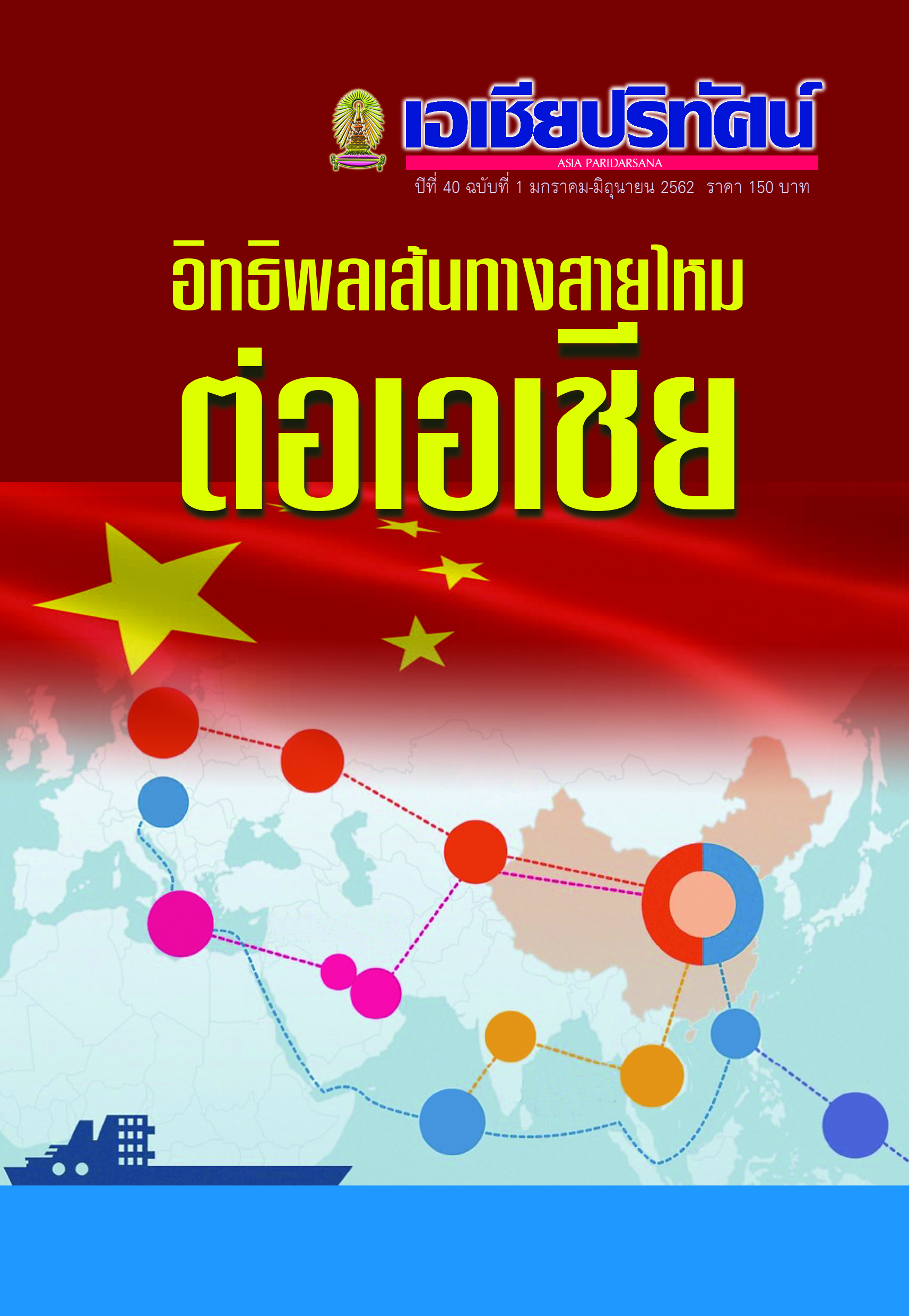ทางสายไหมใหม่ในอาเซียน : หนทางสู่ความร่วมมืออย่างยั่งยืน?
Main Article Content
Abstract
The progress of the BRI (Belt and Road Initiative) project has started to deviate from the directions adopted in the agreement with ASEAN. The relation of the project with ASEAN has thus been filled with ambiguity, resulting in a doubt about whether the project remains a significant economic prospect for the community.
To clear this doubt, this article proposes to unveil the meaning of BRI from the ASEAN’s perspective. It provides an overview of the project, beginning with a discussion of the information and scholarly viewpoints on the project, and then linking an understanding of the problems to the answer to the issue of doubt about its implications for ASEAN. The problems relating to the BRI include the following: (1) the project is principally China’s initiative, which lacks adequate understanding of real needs in the local community; (2) it suffers from weaknesses resulting from a lack of popular support; (3) representing an international influence from outside ASEAN, it is seen as the most significant factor; and (4) it has an unclear image of sustainability. However, the project is still proceeding without a high level of resistance. The concept of BRI in the eyes of ASEAN is hence neither a must-grab opportunity nor a threat. It has become a temporary option awaiting change for the better.
Article Details
References
กอแก้ว จันทร์กิ่งทอง และคณะ. 2559. ผลกระทบและความเป็นไปได้ในการดำเนินโครงการขุดคลองไทย (คอคอดกระ).
กรุงเทพฯ : บริษัท คิงส์แลนด์ (ประเทศไทย) จำกัด.
ดลหทัย จิรวิวรรธน์. 2559. คลองไทย: ประเด็นที่ต้องพิจารณา และ การเตรียมความพร้อมด้านกฎหมาย. กรุงเทพฯ: คณะนิติศาสตร์ มหาวิทยาลัยธรรมศาสตร์.
“’ไทย–จีน’ ผนึกความร่วมมือดันเป้ายอดการค้า 1.4 แสนล้านดอลล์.” 2561. กรุงเทพธุรกิจ, 25 สิงหาคม, http://www.bangkokbiznews.com/news/detail/811240.
ธนิต โสรัตน์. 2560. เอกสารการประชุม กมธ.คมนาคม สนช. เรื่อง โครงการขุดคลองไทยสมุทรทานุภาพทางเศรษฐกิจ...ใครได้ประโยชน์ โดย คณะกรรมาธิการคมนาคม. กรุงเทพฯ: สภานิติบัญญัติแห่งชาติ (สนช.).
โบ เหลืองทอง. 2561. “อาเซียน-ไทย ร่วมฝึกซ้อม RIMPAC.” รายงานพิเศษ ช่อง 7HD. กรกฏาคม 23.
ปิยนุช ผิวเหลือง. 2559. “‘อาเซียน’ศูนย์กลาง เส้นทางสายไหมใหม่.” โพสต์ทูเดย์, 13 กรกฎาคม, เข้าถึงเมื่อ 30 กรกฎาคม 2561. https://www.posttoday.com/aec/scoop/442792.
ภิญญพันธุ์ พจนะลาวัณย์. 2558. “พลวัตของการกลายเป็นท้องถิ่นของ “ความเป็นญี่ปุ่น” ในประเทศไทยตั้งแต่ทศวรรษ 2520.” วารสารญี่ปุ่นศึกษา 32(2):27-46.
“วิศวกรชาวจีนเดินหน้าสร้างเส้นทางสายไหม 2.0.” 2561. Science: Illustrated, สิงหาคม, 44-47.
สถาบันขงจื่อเส้นทางสายไหมทางทะเล. ม.ป.ป. “สถาบันขงจื่อในประเทศไทย.” เข้าถึงเมื่อ 6 สิงหาคม 2561. http://www.dpu.ac.th/msrci/about.php.
สำนักงานภาคเหนือ ส่วนเศรษฐกิจภาค. ม.ป.ป. เส้นทางสายไหม...ยุทธศาสตร์การขยายอิทธิพลของจีนต่อเศรษฐกิจโลก. กรุงเทพฯ : ธนาคารแห่งประเทศไทย.
สานักเอเชีย แอฟริกา และยุโรปตะวันออก. 2558. จีนกับประชาคมเศรษฐกิจอาเซียน ภายใต้แผนพัฒนาเส้นทางสายไหม ใหม่. สืบค้น 30 กรกฎาคม 2561. http://www.dtn.go.th
Camba, Alvin A, and Kuek Jia Yao. 2018. “Commentary: China’s Belt and Road Initiative Paved with Risks, Red Herrings and Rent-Seeking Behaviour.” Channelnewsasia, Accessed July 30 2018. https://www.channelnewsasia.com/news/commentary/china-belt-road-initiative-risk-red-herring-rent-seeking-10475036.
Chellaney, Brahma. 2017. “Sri Lanka the Latest Victim of China’s Debt-Trap Diplomacy.” Asia Times Holdings Limited, Accessed August 13 2018. http://www.atimes.com/article/sri-lanka-latest-victim-chinas-debt-trap-diplomacy/Council on Foreign Relations. 2018. “What Is the Trans-Pacific Partnership (TPP)?” Council on Foreign Relations, Accessed August 19. https://www.cfr.org/backgrounder/what-trans-pacific-partnership-tpp.
Hang, Nguyen Thi Thuy. 2018. “The U.S.-ASEAN Relations: An Overview.” Slovak Journal of Political Sciences 18 (1):69-83.
Hurley, John, Morris, Scott, and Portelance, Gailyn. 2018. Examining the Debt Implications of the Belt and Road Initiative from a Policy Perspective, CGD Policy Paper 121. Washington DC: Center for Global Development.
International Cooperation Bureau. 2017. Priority Policy for Development Cooperation FY 2017. Tokyo: MOFA.
Jetin, Bruno. 2017. “One Belt-One Road Initiative” and ASEAN Connectivity: Synergy Issues and Potentialities. Gadong: Institute of Asian Studies, Universiti Brunei Darussalam.
Jun, Xie, and Chen Qingqing. 2018. “B&R Faces ASEAN Uncertainty “ Global Times, June 7. Accessed August 19, 2017. http://www.globaltimes.cn/content/1109689.shtml
Junchi, Ma. 2017. “The Challenge of Different Perceptions on the Belt and Road Initiative.” CIRR XXIII 78:149-168.
Lee, John. 2018. “ASEAN Must Engage over Maritime Security.” Nikkei Inc. Accessed August 19. https://asia.nikkei.com/Opinion/ASEAN-must-engage-over-maritime-security
Leung, Christy. 2018. “Hong Kong’s ICAC Chief Warns of Corruption in Belt and Road Countries.” South China Morning Post, July 3. Accessed July 30, 2018. https://www.scmp.com/news/hong-kong/hong-kong-law-and-crime/article/2153483/hong-kongs-icac-chief-warns-corruption-belt.
Lim, Linette. 2018. “Growing Doubts over China’s Belt and Road Projects in Southeast Asia.” Channel NewAsia, August 13. Accessed December 19, 2018. https://www.channelnewsasia.com/news/asia/belt-and-road-growing-doubts-projects-southeast-asia-10612242
Morrison, Wayne M. 2018. China’s Economic Rise: History, Trends, Challenges, and Implications for the United States. Washington, D.C.: Congressional Research Service.
Ministry of Foreign Affairs of the People’s Republic of China. 2018. Speech by Ambassador Huang Xilian at China-ASEAN Belt and Road Business Forum. Beijing.
Office of Archives and History. 1988. The Suez Crisis: A Brief Comint History (U). edited by National Security Agency. Maryland: Central Security Service.
Parameswaran, Prashanth. 2017. “China Plays Up ASEAN Confucius Institute Presence With Laos Project.” The Diplomat, October 6.
Parpart, Erich. 2018. “Belt Tightening.” Bangkok Post, 30 July Business News. Accessed July 30, 2018. https://www.bangkokpost.com/ business/news/1512518/belt-tightening.
Petri, Peter A., and Michael G. Plummer. 2014. ASEAN Centrality and the ASEAN-US Economic Relationship. Hawaii: East-West Center.
Report on the Sustainable Development of Chinese Enterprises Overseas. 2017. Beijing: Chinese Academy of International Trade and Economic Cooperation (Ministry of Commerce of the People’s Republic of China), Research Centre of the State-owned Assets Supervision and Administration Commission of the State Council of the People’s Republic of China, and United Nations Development Programme China.
Singh, J.P., and MacDonald, Stuart. n.d. Soft Power Today: Measuring the Influences and Effects. Edinburgh: The Institute for International Cultural Relations, School of Social and Political Science, The University of Edinburgh.
Siphana, Sok. 2016. Strategies Oerspective on the One Belt, One Road and ASEAN: Aievements, Challenges, Opportunities and Future Direction. In Expert Commentary, edited by ASEAN Advisory Subject Matter Experts. Singapore: ZICO Advisory.
Srisakdi Charmonman, and Pornphisud Mongkhonvanit. 2014. “Information Technology Preparation to Enter ASEAN Community.” International Journal of the Computer, the Internet and Management 22 (2):1-6.
Switzer, Andrew. 2017. “The Consequences of Confucius Institutes: Understanding the Opposition.” Master, Faculty of the Graduate School of Arts and Sciences, Georgetown University.
The ASEAN Secretariat. 2017. Joint Statement between ASEAN and China on Further Deepening the Cooperation on Infrastructure Connectivity. Jakarta ASEAN.org.
“Bumps of Belt and Road Initiative in the Rear-View Mirror.” 2018. The Nation, July 6. http://www.nationmultimedia.com/detail/opinion/30349420.
Thipakorn, Saikaew. 2013. “Japan’s Cultural Diplomacy in Thailand, 1970s-1980s.” PhD, Thai Studies Center, Faculty of Arts, Chulalongkorn University.
UNDP. n.d. Sustainable Development Goals. United Nations Development Programme, http://www.undp.org/content/undp/en/home/sustainable-development-goals.html
Waterworth, Peter. 2016. “Teaching English in ASEAN: The Voices of English Teachers in ASEAN Nations “ Indonesian Journal of Applied Linguistics 5 (2):154-166.
Widodo, Tri. 2016. “Business Sector in Japan-ASEAN Relations.” In Japan-ASEAN: Business and Cultural Relations, edited by Saikaew Thipakorn and Thanayod
Lopattananont, 29-73. Bangkok: ASEAN Studies Center (Chulalongkorn University), Institute of Asian Studies, Chulalongkorn University, and Japan Foundation


